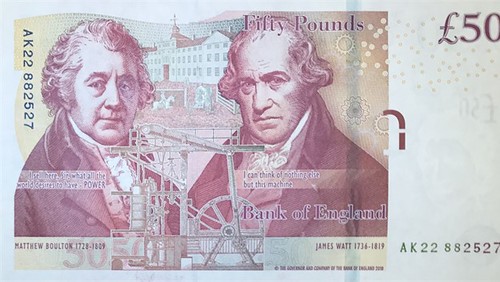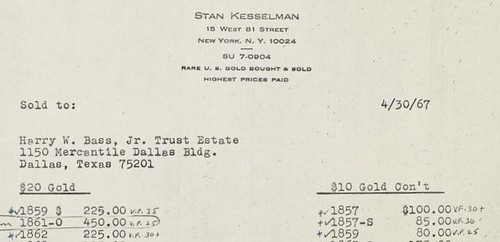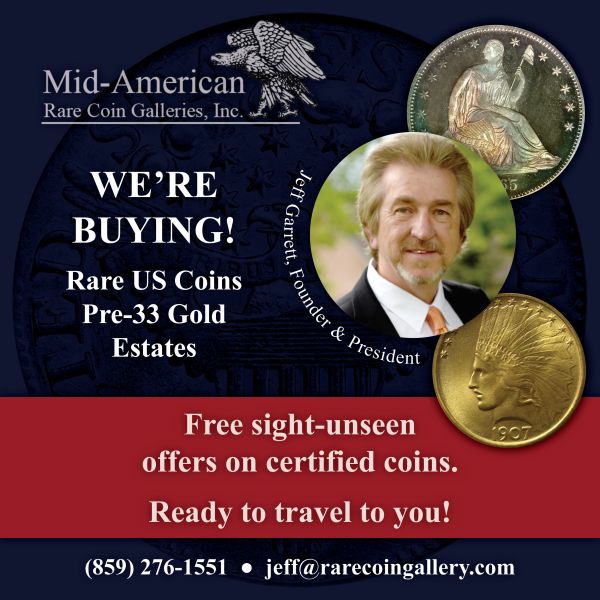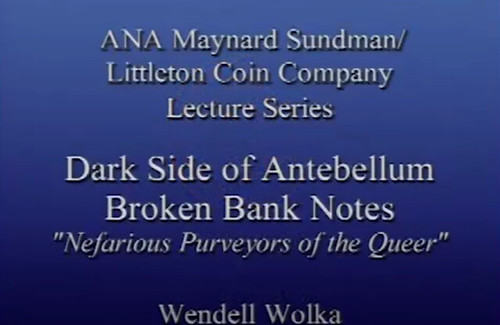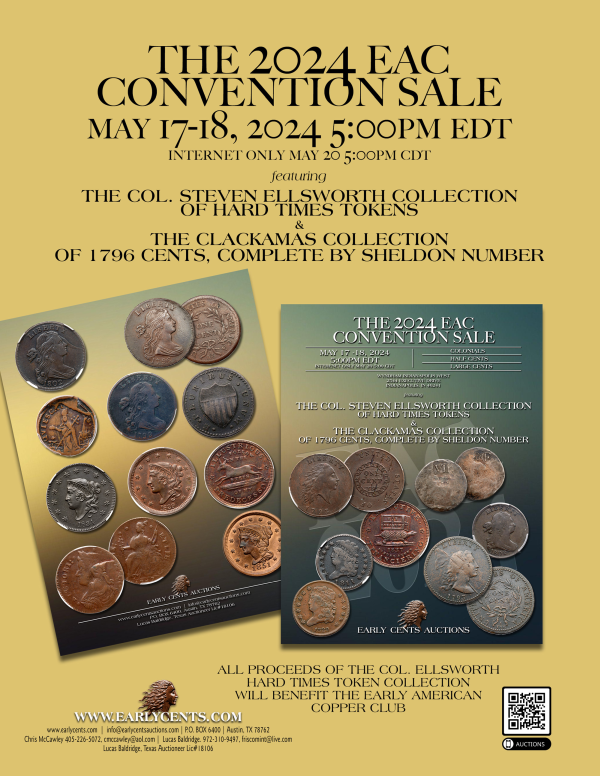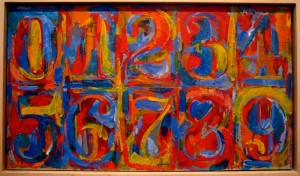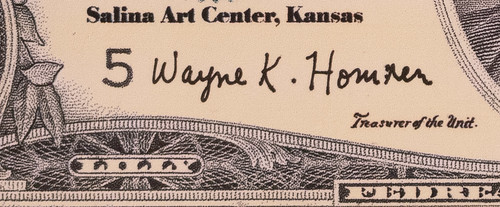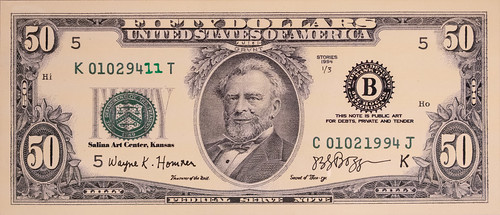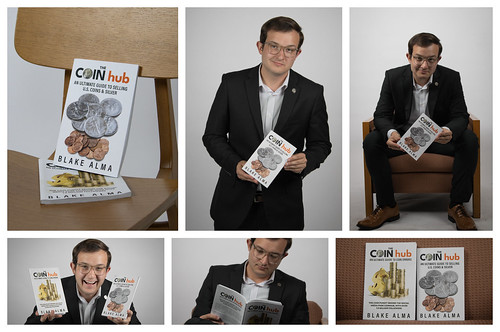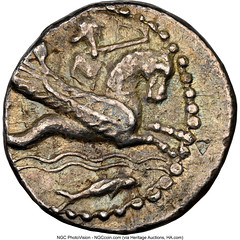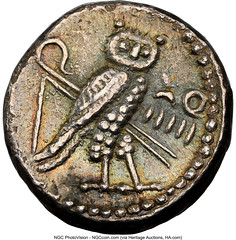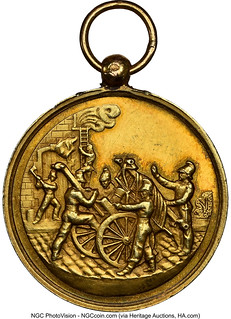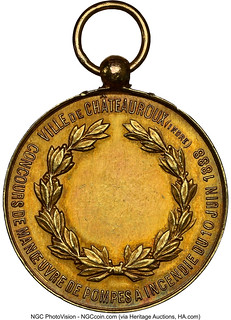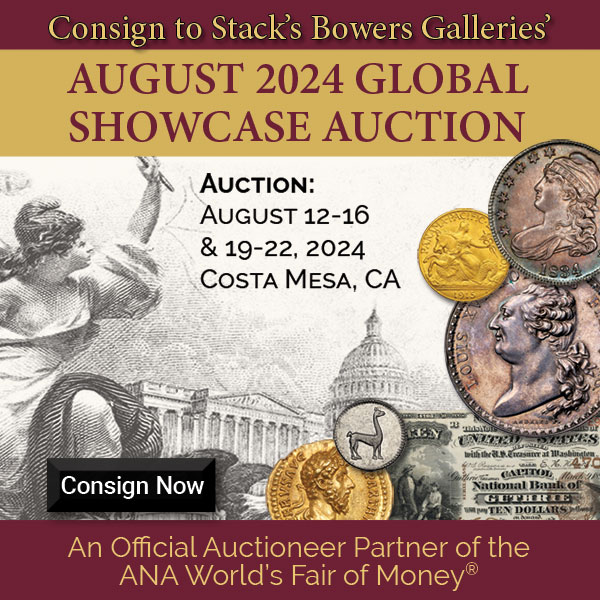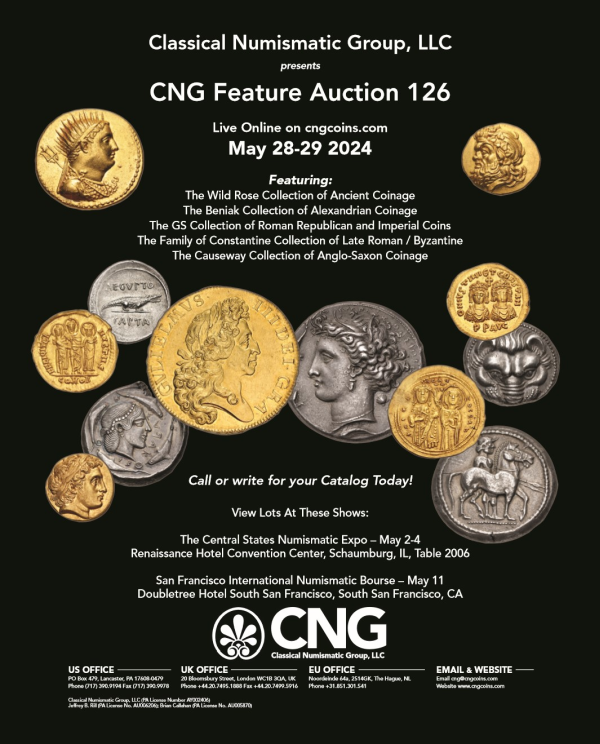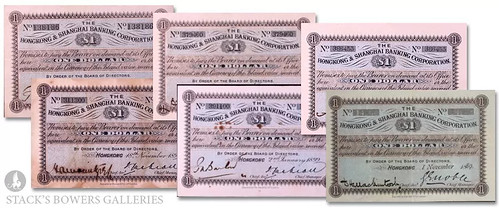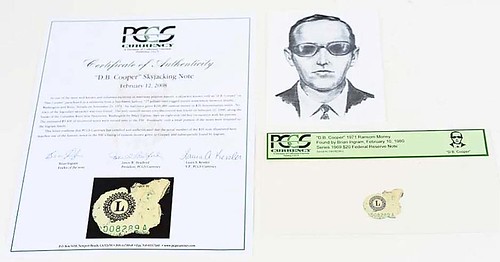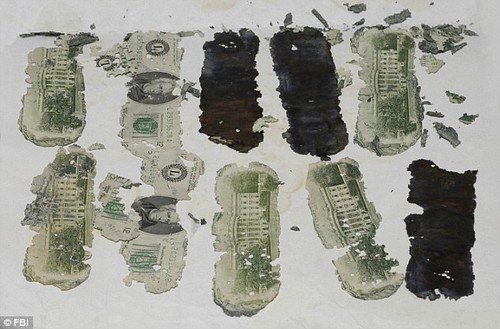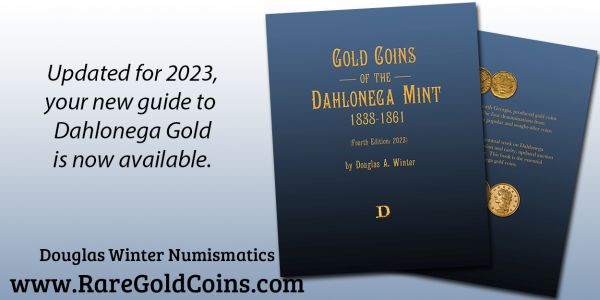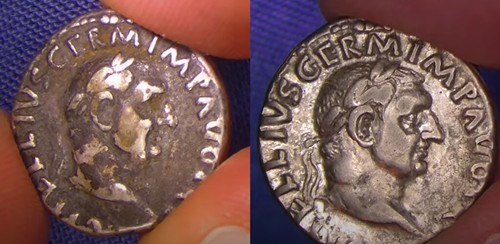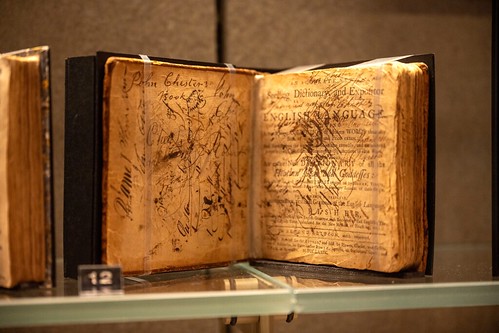
Visit our NBS Sponsors



About UsThe Numismatic Bibliomania Society is a non-profit association devoted to the study and enjoyment of numismatic literature. For more information please see our web site at coinbooks.org SubscriptionsThose wishing to become new E-Sylum subscribers (or wishing to Unsubscribe) can go to the following web page link MembershipThere is a membership application available on the web site Membership Application To join, print the application and return it with your check to the address printed on the application. Print/Digital membership is $40 to addresses in the U.S., and $60 elsewhere. A digital-only membership is available for $25. For those without web access, write to: Jeff Dickerson, Treasurer AsylumFor Asylum mailing address changes and other membership questions, contact Jeff at this email address: treasurer@coinbooks.org SubmissionsTo submit items for publication in The E-Sylum, write to the Editor at this address: whomren@gmail.com BUY THE BOOK BEFORE THE COIN |
- WAYNE'S WORDS: THE E-SYLUM MAY 12, 2024
- NEW BOOK: MONETA: ANCIENT ROME IN TWELVE COINS
- NEW BOOK: CORPUS OF MUGHAL COINS OF INDIA, VOL 2
- NEW BOOK: ESSLINGEN ART MEDALS
- STAN KESSELMAN PAPERS ON NEWMAN PORTAL
- VIDEO: ANTEBELLUM BROKEN BANK NOTES
- ON ERROR COLLECTING
- CONECA TO EXAMINE ERROR AND VARIETY COINS
- COMMENTS: WHY BOGGS? WHY NOW?
- NOTES FROM E-SYLUM READERS: MAY 12, 2024
- BOULTON & WATT 250TH ANNIVERSARY
- VOCABULARY TERM: PLAQUETTE
- RICHARD W. SUTER
- MORE ON BLAKE ALMA'S NEW BOOK
- HERITAGE AUCTIONS: FROM FAUNA TO FABLES
- HERITAGE MAY 2024 MEDALS & TOKENS SELECTIONS
- FRANK ROBINSON OFFERS “HOLEY COLLECTION"
- CALIFORNIA COIN CONTEST COMEDIANS
- HAYM SALOMON BRONZE MINI-MEDAL OFFERED
- HONG KONG “SMALL CHEQUE” DOLLAR NOTES
- D.B. COOPER RANSOM REMNANT SELLS
- LOOSE CHANGE: MAY 12, 2024
- AUSTRALIA'S MACQUARIE BANK DITCHES CASH
- HISTORY OF THE ENGLISH DICTIONARY
- FEATURED WEBPAGE: 19TH CENTURY SILVER INGOTS
Content presented in The E-Sylum is not necessarily researched or independently fact-checked, and views expressed do not necessarily represent those of the Numismatic Bibliomania Society.
WAYNE'S WORDS: THE E-SYLUM MAY 12, 2024
 New subscribers this week include:
Welcome aboard! We now have 7,264 subscribers.
New subscribers this week include:
Welcome aboard! We now have 7,264 subscribers.
Thank you for reading The E-Sylum. If you enjoy it, please send me the email addresses of friends you think may enjoy it as well and I'll send them a subscription. Contact me at whomren@gmail.com anytime regarding your subscription, or questions, comments or suggestions about our content.
This week we open with three new books, updates from the Newman Numismatic Portal, error collecting, and more.
Other topics this week include art medals, broken bank notes, Boulton & Watt, plaquettes, coins with holes, Hong Kong small cheque notes, D. B. Cooper ransom notes, and a big bank going cashless.
To learn more about ancient Rome in twelve coins, the Mughal coins of India, Stan Kesselman, Haym Salomon, CONECA, the "Treasurer of the Unit", the Wells Fargo History Museum, the Soho Mint, How Not to Get Ripped Off in the Coin Business, animals on ancient coins, a calendar medal, and "Nefarious Purveyors of the Queer", read on. Have a great week, everyone!
Wayne Homren
Editor, The E-Sylum
NEW BOOK: MONETA: ANCIENT ROME IN TWELVE COINS
If you could pick just twelve ancient roman coins, which would you choose? Twelve Caesars? Been done to death. How about twelve coins representing the entire history of the Roman empire? This new book uses coins as a portal to ancient times. -Editor
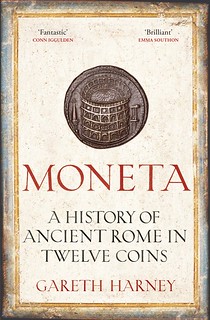 Moneta
Moneta
A History of Ancient Rome in Twelve Coins
By Gareth Harney
The extraordinary story of ancient Rome, history's greatest superpower, as told through humankind's most universal object: the coin.
- 'Fantastic' CONN IGGULDEN, author of Nero
- 'Brilliant' EMMA SOUTHON, author of A History of the Roman Empire in 21 Women
- 'Wonderful' CHRISTOPHER HADLEY, author of The Road
Moneta traces ancient Rome’s unstoppable rise, from a few huts on an Italian hilltop to an all-conquering empire spanning three continents, through the fascinating lives of twelve remarkable coins. In these handcrafted pieces of ancient art we witness Caesar's bloody assassination, follow the legions to the edge of the known world, take a seat in the packed Colosseum, and ultimately, watch as barbarian armies mass at the gates.
NEW BOOK: CORPUS OF MUGHAL COINS OF INDIA, VOL 2
Volume 2 in a series of books on the Mughal Coins of India has been published. -Editor
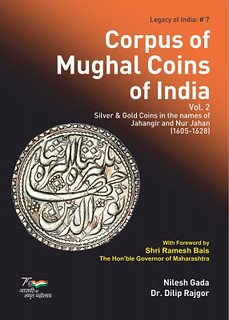 Corpus of Mughal Coins of India, Volume 2: Silver and Gold Coins in the names Of Jahangir and Nur Jahan
Corpus of Mughal Coins of India, Volume 2: Silver and Gold Coins in the names Of Jahangir and Nur Jahan
Nilesh Gada (Author)
Dilip Rajgor (Author)
Legacy of India
Corpus of Corpus of Mughal Coins of India is a series of six volumes. Mughal Coins The Corpus deals with all the coins issued by Mughal Emperors within modern countries of India, Pakistan, Afghanistan, Uzbekistan, Tibet, Nepal & Bangladesh from 1526 to 1858. These coins include not only all the coins issued by the Mughal Emperors, but also all the coins issued by provincial rulers in the name and style of these Mughal Emperors. These include Independent Kingdoms, Princely States and East India Company.
NEW BOOK: ESSLINGEN ART MEDALS
The city of Esslingen, Germany issued a series of 26 art medals depicting local history and architecture from 1997 to 2009. a new book by medallist Victor Huster documents the series. Here's the announcement. -Editor
Portrait of a city
The series of art medals has now been published as a book
A series of art medals reflecting the culture and history of the former Free Imperial City of Esslingen am Neckar was created over a period of 13 years. These 26 outstanding works of art in terms of design and minting technique are now documented in a printed book.
The 65-page ensemble is based on in-depth thematic research and intensive design work. Executed using elaborate minting techniques, the result is a unique city portrait that is unrivalled in the world of German medals. In addition to architecture and historical milestones, the range of themes also includes selected personalities and examples of local industrial development. The series, which grew from 1997 to 2009, is due not least to the ongoing commitment of Kreissparkasse Esslingen.
STAN KESSELMAN PAPERS ON NEWMAN PORTAL
The latest addition to the Newman Numismatic Portal is the Stan Kesselman Papers. Project Coordinator Len Augsburger provided the following report. -Editor
Stan Kesselman Papers on Newman Portal
In between the mass of public advertisements and named auction catalogs, a few dealers operate quietly, facilitating the placement of important numismatic items into equally important collections. One of these dealers was the New York numismatist Stan Kesselman. Among others, Kesselman worked with Harry W. Bass, Jr. to build a historic collection of U.S. gold coinage, which was ultimately featured in auction sales by Bowers & Merena (1999-2000) and Heritage Auctions (2022-2023). Other clients included the large cent collector Roy Naftzger.
Business records of Kesselman, primarily invoices with an emphasis on gold coins, are currently being digitized by Newman Portal. Occasional correspondence is also present, such as a letter from Bass to Kesselman, January 19, 1968, which alludes to the never-ending negotiation between dealer and client: “I agree - once you pay too much, it sets you up for life. With you by now I must have set myself up for a hundred lifetimes. Since I have paid you too much so many times in the past, why shouldn't I continue so doing in the future? My problem with you is that you now know how much you can get away with. I don't need salt for my wounds but rather balm as well as a solution to my problem.”
VIDEO: ANTEBELLUM BROKEN BANK NOTES
The David Lisot Video Library on the Newman Numismatic Portal can be found at:
https://nnp.wustl.edu/library/multimediadetail/522852
We highlight one of his videos each week in The E-Sylum. Here's one from 2005 with Wendell Wolka speaking about paper money before the Civil War-era Federal issues. -Editor
ON ERROR COLLECTING
Vic Mason of Mamaroneck, NY submitted these notes on error coins. Thank you. -Editor
Last week’s edition of The E-Sylum highlighted David Lisot’s 2005 video of the scintillating meeting led by Sid Kass and Fred Weinberg about the history and progress of error-coin collecting in this country. Entitled: “Early Days of Error Coin Collecting,” the video was very enjoyable and informative. What a wonderful video archive David Lisot built up at ANA conventions and other meetings before his untimely passing.
The evolution of error-coin collecting has had such a dramatic impact on the hobby. No one has been more important for popularizing that endeavor than Bill Fivaz and the late J.D. Stanton, thanks to their wonderful series of Cherry Pickers’ Guides. It was good to see Mr. Fivaz in that video, then obviously in his vigorous early 70s, bantering with others in the audience.
THE BOOK BAZARRE
CONECA TO EXAMINE ERROR AND VARIETY COINS
While we're on the topic of errors, the CONECA organization will be manning tables at upcoming coin shows to examine error and variety coins. Here's the press release. -Editor
at Major Coin Shows Across the USA
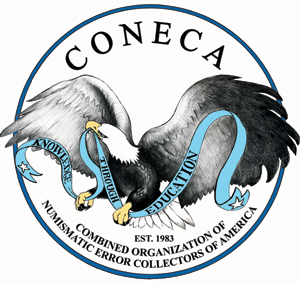 CONECA, the international error coin and variety club, will be offering free examination of error and
variety coins to collectors at educational tables at coin shows across the United States throughout
this year and into next.
CONECA, the international error coin and variety club, will be offering free examination of error and
variety coins to collectors at educational tables at coin shows across the United States throughout
this year and into next.
The club, whose name stands for “Combined Organizations of Numismatic Error Collectors of America,” is the largest coin specialty club in the United States and has actively been educating collectors about mint error and variety coins for the last five decades.
At their coin show tables, different members of the CONECA Board of Directors and other error / variety enthusiasts (each with different areas of specialty as available) will offer free examination to collectors who bring coins from their collection to the show with questions.
COMMENTS: WHY BOGGS? WHY NOW?
Several comments have come in on the video of my recent talk on money artist J.S.G. Boggs at Washington University in St. Louis. -Editor

Clifford Mishler writes:
"I enjoyed sitting in on your Boggs program at Central States."
Bill Eckberg writes:
"Really great talk. You were very natural and gave great information.
"For some reason, despite my interest in numismatics, art and science, I missed learning about him. I wish I had."
Gosia Fort writes:
"I loved it. You made me sit glued to the computer screen soaking your every word. Sure Boggs was an interesting person and I have heard you talking about him before, but this lecture was absolutely wonderful. What a delivery!"
Others wrote:
"I have watched your presentation. Very educational."
"While I have been enjoying all of the presentations, I enjoyed this one the most. Well done!"
"Much enjoyed it. Learned a lot. He was certainly ahead of his time, as were you in recognizing his significance."
The reader also noted Jasper John's numbers works, which parallel Boggs' early interest in the form of numbers. -Editor
For more information, see:
https://www.moma.org/collection/works/series/74613
https://whitney.org/collection/series/4390
https://n4mb3rs.com/jasper-johns-painting-numbers/
Jim Haas was unable to read the text under Boggs' rendition of my signature on the exhibited $50 bill, so I sent him a higher resolution image. It's "Treasurer of the Unit." -Editor
Jim writes:
"So from now on I will refer to you as the Honorable Treasurer."
Edwin Johnston was inspired to ask AI to create a $5,000 Boggs bill. -Editor
Another viewer wrote:
"I loved the presentation. You are a great storyteller. The question in mind is how did Boggs end up teaching at the university without a degree?"
I knew just who to ask for an answer to that question - Robert Cavalier, who helped bring Boggs to the CMU Philosophy department: "We could be pretty creative when opportunities arose for hiring someone outside the regular channels. Because we were interested in doing some multimedia work with Boggs he was given a special “research” position. There was no formal classroom teaching involved."
Thanks, everyone. -Editor
To read the earlier E-Sylum articles, see:
WASHINGTON UNIVERSITY IN ST. LOUIS EXHIBITS
(https://www.coinbooks.org/v27/esylum_v27n07a06.html)
VIDEO: WHY BOGGS? WHY NOW?
(https://www.coinbooks.org/v27/esylum_v27n17a08.html)
NOTES FROM E-SYLUM READERS: MAY 12, 2024
Philippine Emergency Currency Book Thanks
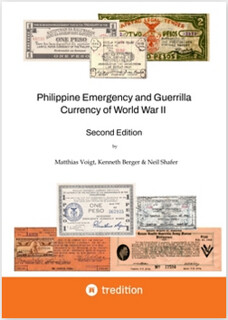 Joel Shafer writes:
Joel Shafer writes:
"I wanted to share how delighted the Neil Shafer family is with the publication of the updated "Philippine Emergency and Guerrilla Currency of World War II". Our family is very grateful for Matthias Voigt's and Ken Berger's tireless efforts. My father worked on this project until he physically could no longer do so (up until about two weeks before he passed); this project meant the world to him and hopefully it will significantly further the understanding of this currency."
Ken Berger adds:
"A more detailed write up about Conrad Nielsen appeared in the 7 May 2017 E-Sylum."
To read the earlier E-Sylum article, see:
NEW BOOK: PHILIPPINE EMERGENCY CURRENCY 2ND ED.
(https://www.coinbooks.org/v27/esylum_v27n18a03.html)
CONRAD MOWER NIELSEN (1922-2008)
(https://www.coinbooks.org/v20/esylum_v20n19a13.html)
Other topics this week include Jane MacAdam Freud, Wayne C. Phillips, the NASC Money Museum, and Paper Money Chopmarks. -Editor
BOULTON & WATT 250TH ANNIVERSARY
Laurence Edwards of the Chicago Coin Club submitted this reminder of a significant numismatic anniversary. Thank you! -Editor
James Watt left Glasgow – he had worked as a technician at the University of Glasgow -- in May of 1774 and arrived in Birmingham on the last day of that month – so, almost exactly 250 years ago! The engineering genius of the Scottish Enlightenment shook hands with Matthew Boulton, one of the pioneers of English industrialization.
James Watt is the more famous name – well-known to anyone who has ever checked the brightness of a lightbulb. Watt did not invent the steam engine, but improved it in ways that made it central to the Industrial Revolution.
VOCABULARY TERM: PLAQUETTE
Here's another entry from Dick Johnson's Encyclopedia of Coin and Medal Terminology. -Editor
Plaquette. An art relief smaller than eight inches (or more precisely, 20 centimeters), which bears a bas-relief design. While plaquettes are usually considered square, rectangular, or nearly so, they appear in a variety of shapes, and can be somewhat more creative with silhouetted, open work, sunken relief, or other sculptural techniques. Plaquettes do not share the restrictions of a round medallic item. In effect, plaquettes are the most artistic – and because they can be easily mounted – the most utilitarian form of medallic art.
RICHARD W. SUTER
E-Sylum Feature Writer and American Numismatic Biographies author Pete Smith submitted this article on coin business huckster Richard W. Suter. Thanks! -Editor
In the past, The E-Sylum has noted numismatic authors who have been sentenced to prison. The short list includes Dale Estin Birdsell, Walter Breen, Robert Harry Burnie, Charles Lynn Glazer and Frank Albert Lapa. This week another might be added to the list, if his book exists.
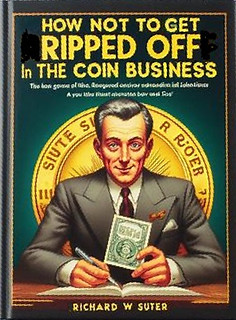 Richard W. Suter was identified as the author of How Not to Get Ripped Off in the Coin
Business. The book was marketed through Suter’s National Investment Publication Co. This is
apparently quite a scarce title.
Richard W. Suter was identified as the author of How Not to Get Ripped Off in the Coin
Business. The book was marketed through Suter’s National Investment Publication Co. This is
apparently quite a scarce title.
In April of 1973, a Richard W. Suter joined the ANA from Sierra Madre, California as Member R-74189. Another Richard W. Suter joined the ANA in May 1974 as member R-79267 from Chicago, Illinois. In 1981 member R-79267 was expelled from the ANA for failure to fulfill coin orders.
Coin World published a flattering description of Suter in their issue of May 28, 1975:
“Mr. Suter is a frequent lecturer on investments or survival and has appeared on radio and television from coast to coast. He is a contributing editor to Inflation Survival Letter published by Human Events, America’s leading conservative news weekly and a columnist in Inflation Early Warning System published by The Capitalist Reporter. Mr. Suter is an experienced and successful commodities trader and rare coin investor.”
MORE ON BLAKE ALMA'S NEW BOOK
Last week we mentioned the new book by Blake Alma of CoinHub. Here's a new press release I came across this week. -Editor
Blake Alma, an acclaimed numismatist and CEO of CoinHub Media, has authored An Ultimate Guide to Selling U.S. Coins and Silver, which is the latest release in "The CoinHub Series." Climbing swiftly to become the number one new release in coins and precious metals on Amazon, this guide offers a wealth of knowledge for turning coin collecting into a profitable pursuit.
HERITAGE AUCTIONS: FROM FAUNA TO FABLES
Heritage published this preview of their upcoming From Fauna to Fables World and Ancient Coins Showcase Auction. Some nice coins here. -Editor
The Animals: From Fauna to Fables World and Ancient Coins Showcase Auction is a specialized Showcase exclusively featuring coinage adorned with animals, both real and mythical. This unique auction spans a broad timeline, offering both ancient treasures and modern marvels, with each piece carefully selected for its depiction of the animal kingdom. Enthusiasts and collectors will have the opportunity to explore a diverse array of coins that demonstrates the development of zoology throughout the centuries. This Showcase promises an unparalleled journey through numismatics, where history, art, and the natural world converge in every coin.
This auction consists primarily of ancient coins, which feature quite a number of mythical beasts. One piece with a particularly full bestiary is an AR shekel or didrachm from Tyre, minted in 335/4 BC. Graded Choice XF 4/5 - 4/5 by NGC, the obverse of this piece features a bearded deity, probably Melqart, riding a winged hippocampus, a creature with the upper body of a horse and the lower body of a fish. Below, in the water, a dolphin is visible. Completing the bestiary on the reverse of the coin is an owl.
HERITAGE MAY 2024 MEDALS & TOKENS SELECTIONS
Here are some selections from the upcoming May 2024 Heritage Medals & Tokens Showcase Auction. -Editor
"Firefighting Competition" gold Medal 1888-Dated UNC Details (Test Cut) NGC, 30mm. 14.57gm. Commemorating the Fire Pump Operation competition of June 10, 1888 at the Ville de Chateauroux. Unawarded.
FRANK ROBINSON OFFERS “HOLEY COLLECTION"
Holy holed coins, Batman! Dealer Frank Robinson is offering a collection of holed coins. -Editor
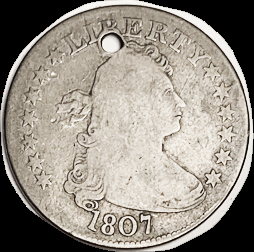 Dealer Frank S. Robinson will conduct a special auction of “The Holey Collection,” closing June 5, with all holed coins. The sale, with no buyer fee, includes about 270 lots, many of them group lots.
Dealer Frank S. Robinson will conduct a special auction of “The Holey Collection,” closing June 5, with all holed coins. The sale, with no buyer fee, includes about 270 lots, many of them group lots.
Most coins are from one collector, who seemed to love holed coins. After all, one can get 98% of the coin for, usually, a fraction of the price.
The sale includes U.S. and mostly world coins. One notable item is a U.S. 1822 dime, a very rare date, with a plugged hole.
The catalog is posted at www.fsrcoin.com/holey.html
CALIFORNIA COIN CONTEST COMEDIANS
Everyone's a comedian (or political commentator). California is seeking design ideas for a 2026 quarter, and submitters are taking the opportunity to joke about less commemoration-worthy aspects of the state. -Editor
Paul Horner writes:
"Here is an article on the "Tortured coin designs" for California's innovation dollars - homeless camps, fires, etc."
HAYM SALOMON BRONZE MINI-MEDAL OFFERED
A medal commemorating the American Revolution financial hero Haym Salomon is available from the Jewish-American Hall of Fame. -Editor
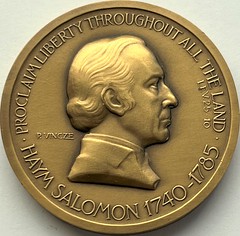 With the 250th anniversary of American Independence coming up in 2026, the Jewish-American Hall of Fame would like to remind everyone of the critical contributions made by Haym Salomon. Salomon was arrested by the British twice as a spy; he was sentenced to death but managed to escape. Afterwards he began working with Robert Morris, the newly appointed Superintendent for Finance, to raise money for the Thirteen Colonies. When Salomon died at the age of 44, his family was left penniless. An 1864 Congressional report recommended that the government appropriate Salomon’s son the amount of Government obligations held by his father at the time of his death -- $353,729.43 (approximately 10 million dollars in 2023 dollars). But this did not happen.
With the 250th anniversary of American Independence coming up in 2026, the Jewish-American Hall of Fame would like to remind everyone of the critical contributions made by Haym Salomon. Salomon was arrested by the British twice as a spy; he was sentenced to death but managed to escape. Afterwards he began working with Robert Morris, the newly appointed Superintendent for Finance, to raise money for the Thirteen Colonies. When Salomon died at the age of 44, his family was left penniless. An 1864 Congressional report recommended that the government appropriate Salomon’s son the amount of Government obligations held by his father at the time of his death -- $353,729.43 (approximately 10 million dollars in 2023 dollars). But this did not happen.
HONG KONG “SMALL CHEQUE” DOLLAR NOTES
Stack's Bowers Director and Senior Numismatist Dr. Kelvin Cheung published an article about the Hong Kong "small cheque" dollar notes. -Editor
Issued by HSBC from 1889 to 1899
Stack’s Bowers and Ponterio is pleased to offer an early “sneak peek” of highlights from their October Hong Kong Auction – a superb group of high grade One Dollar notes.
The April Hong Kong auction was a phenomenal success with most high ticket items sold and the banknote department hitting an all-time high with sales just exceeding $3.6 million (including the buyer’s premium). This clearly demonstrates the strength of our auction in face of an uncertain global economic climate.
D.B. COOPER RANSOM REMNANT SELLS
"D.B. Cooper" is the airline hijacker who famously parachuted into history on November 24, 1971 with $200,000 in ransom cash. He was never seen again. But some of the banknotes were found. A fractional piece of one ransom note was recently sold. Found via News & Notes from the Society of Paper Money Collectors (Volume IX, Number 47, May 7, 2024). -Editor
A remnant of a $20 bank note, part of the $200,000 ransom paid in 1971 to skyjacker D.B. Cooper and later found by 8-year-old Brian Ingram, was notable in Milestone Auctions’ May 4 spring discovery military sale, eclipsing its $400/600 estimate to finish at $4,920, including buyer’s premium. Ingram famously discovered three bundles of the decomposing currency in 1980 along the Columbia River while on vacation camping with his family near Vancouver, Wash. The Series 1969 $20 Federal Reserve note fragment came with a PCGS Currency certificate identifying the bill. Note fragments with visible serial numbers were traced to the FBI’s original listing for the random notes. Additional highlights from this sale will be featured in a later review.
To read the complete article, see:
Remnant Of Skyjacker D.B. Cooper Banknote Nabs Strong Price At Milestone
(https://www.antiquesandthearts.com/remnant-of-skyjacker-d-b-cooper-banknote-nabs-strong-price-at-milestone/)
To read earlier E-Sylum articles, see:
D. B. COOPER CASH STASH FOR SALE
(https://www.coinbooks.org/esylum_v10n06a11.html)
DISTRIBUTION OF THE KNOWN D.B. COOPER BILLS
(https://www.coinbooks.org/esylum_v10n07a16.html)
D. B. COOPER MYSTERY CONTINUES
(https://www.coinbooks.org/esylum_v18n48a43.html)
CERTIFYING THE D.B. COOPER RANSOM BANKNOTES
(https://www.coinbooks.org/esylum_v19n36a20.html)
LOOSE CHANGE: MAY 12, 2024
Here are some additional items in the media this week that may be of interest. -Editor
Here's a new YouTube video showing the cleaning of an ancient coin. What do readers think of this? -Editor
Cleaning a Roman Denarius minted in 69 during the year of 4 Emperor's under the authority of Emperor Vitellius.
To read the complete article, see:
Restoring a Ancient Roman Silver Denarius (69 AD)
(https://www.youtube.com/watch?v=G75pbPVl4hY)
Other topics this week include Coiniverse and inmates using bags of rice as currency. -Editor
AUSTRALIA'S MACQUARIE BANK DITCHES CASH
So. It's finally come to this - one of the world's leading banks has gone entirely cashless. -Editor
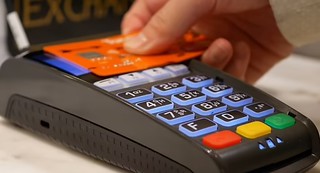 One of Australia's largest banks is ditching cash at all of its branches and shifting entirely to 'digital-only' services.
One of Australia's largest banks is ditching cash at all of its branches and shifting entirely to 'digital-only' services.
Macquarie Bank customers will no longer be able to access over-the-counter services or order new chequebooks from May 20.
The bank's automated telephone banking service and chequebooks for new cash management accounts have already been slashed.
HISTORY OF THE ENGLISH DICTIONARY
We love words at The E-Sylum, and bibliophiles (numismatic or otherwise) should enjoy the new Grolier Club exhibit on the history of the English dictionary. -Editor
Samuel Johnson once joked in a letter that “dictionaries are like watches, the worst is better than none, and the best cannot be expected to go quite true.” The pugnacious English lexicographer may not be a well-known name, but he casts a long shadow on the current definitions of many words in this article. Hardly Harmless Drudgery: Landmarks in English Lexicography, a fascinating exhibition on view on the first floor of the Grolier Club in Manhattan, presents a detailed 500-year timeline of the dictionary’s evolution and its inevitable deconstruction with holdings from several book collectors.
This expansive exhibition of 171 books begins with Renaissance glossaries. These forerunners did not set out to define every known word. Instead, they set a narrower goal of annotating technical terms circulating in particular professions.
FEATURED WEBPAGE: 19TH CENTURY SILVER INGOTS
This week's Featured Webpage is from the Stack’s Bowers Galleries Coin Resource Center on 19th century silver ingots.
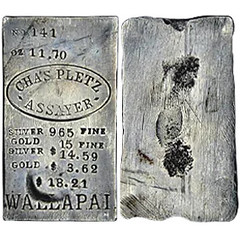 Very little is recorded of Charles Pletz beyond a few bare notices in Arizona’s Weekly Miner newspaper of the mid-1870s. The paper’s issue of May 14, 1875 notes Pletz as superintendent of the Mass Mine while the following June 4 the paper notes Pletz’ interest in mining in the Mineral Park District. For July 9, 1875 the paper stated that Pletz would operate a mining mill at Mineral Park. The issue of October 22, 1875 noted that Pletz had opened an assay office, location not noted. On July 14, 1876 the paper reported that Pletz was to be named supervisor of the Quartz Mounting Mill. On November 17, 1876 the same paper noted Pletz as assistant assayer of the Aztlan Mill and on March 9 of the following year reported that Pletz had sold an interest in the Everett Mine. The last mention of Pletz is a notice in The Miner of November 9, 1932, that describes a place in the Cerbat Mountain where a certain Jack Flynn dug out several hundred pounds of silver ore, samples of which assayed out at Pletz’ assay office at more than $3,000 a ton.
Very little is recorded of Charles Pletz beyond a few bare notices in Arizona’s Weekly Miner newspaper of the mid-1870s. The paper’s issue of May 14, 1875 notes Pletz as superintendent of the Mass Mine while the following June 4 the paper notes Pletz’ interest in mining in the Mineral Park District. For July 9, 1875 the paper stated that Pletz would operate a mining mill at Mineral Park. The issue of October 22, 1875 noted that Pletz had opened an assay office, location not noted. On July 14, 1876 the paper reported that Pletz was to be named supervisor of the Quartz Mounting Mill. On November 17, 1876 the same paper noted Pletz as assistant assayer of the Aztlan Mill and on March 9 of the following year reported that Pletz had sold an interest in the Everett Mine. The last mention of Pletz is a notice in The Miner of November 9, 1932, that describes a place in the Cerbat Mountain where a certain Jack Flynn dug out several hundred pounds of silver ore, samples of which assayed out at Pletz’ assay office at more than $3,000 a ton.
There are only three known Pletz ingots. The ingot from the John J. Ford, Jr. Sale was no. 141. Ingot no. 235 was illustrated in How They Dug the Gold (Arizona Pioneer’s Historical Society, 1967). Mr. Ford contacted the bar’s owner, a Mr. Milton Singer of Bloomfield, Connecticut in August, 1973, asking, without success as it turned out, if the bar were for sale. In his letter to Singer, Mr. Ford mentioned he knew of one other Pletz ingot, bar no. 141. Nearly five years later, on February 20, 1978, Mr. Ford made a second attempt to buy Singer’s Pletz ingot, this time offering $1,000 for it. Mr. Singer again declined to sell the bar, but sent Mr. Ford photographs of it for his files.
Then, on December 17, 1979 Don Kagin received a letter from Mr. Singer asking if there was a Pletz bar in the Clifford Collection. Don forwarded Singer’s letter to Mr. Ford, who replied that there wasn’t and reminded Singer once again of Ford’s interest in buying Singer’s Pletz bar. Singer graciously declined once more, but offered Mr. Ford some information that helped locate Pletz' assay office in Mohave County, Arizona. In December, 1984, Singer wrote Ford saying that his son wanted to have the Pletz bar, implying that it was thereafter “off the market”, but the bar appeared for sale in John Hamilton’s fixed price list offering published in the TAMS Journal in February, 1991. In February, 1993 Hal Birt wrote Ford saying that Hamilton had brought the bar to the recent Tucson show. Its present whereabouts are unknown to the cataloguer and were to Mr. Ford.


